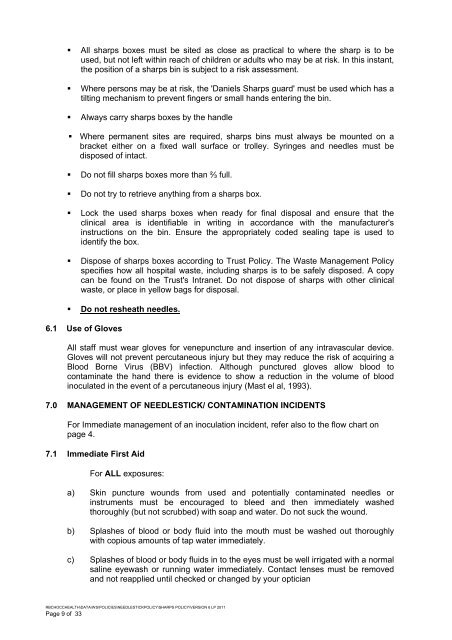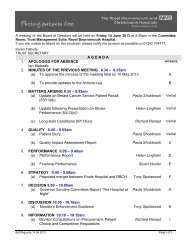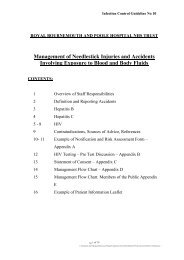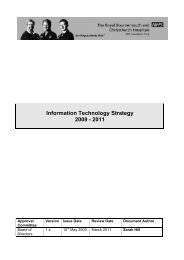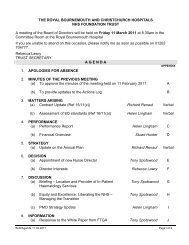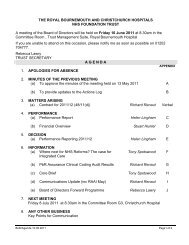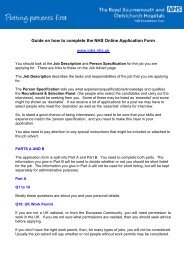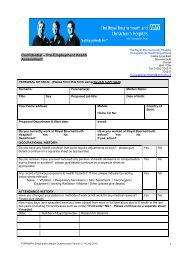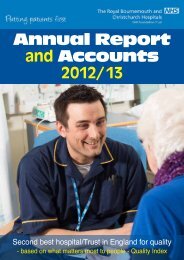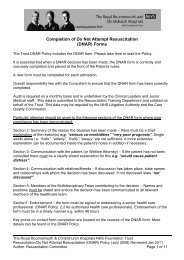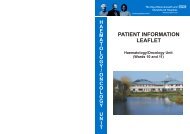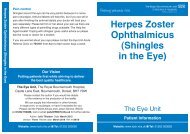Management of Needlestick & Contamination Injuries - Royal ...
Management of Needlestick & Contamination Injuries - Royal ...
Management of Needlestick & Contamination Injuries - Royal ...
- No tags were found...
You also want an ePaper? Increase the reach of your titles
YUMPU automatically turns print PDFs into web optimized ePapers that Google loves.
• All sharps boxes must be sited as close as practical to where the sharp is to beused, but not left within reach <strong>of</strong> children or adults who may be at risk. In this instant,the position <strong>of</strong> a sharps bin is subject to a risk assessment.• Where persons may be at risk, the 'Daniels Sharps guard' must be used which has atilting mechanism to prevent fingers or small hands entering the bin.• Always carry sharps boxes by the handle• Where permanent sites are required, sharps bins must always be mounted on abracket either on a fixed wall surface or trolley. Syringes and needles must bedisposed <strong>of</strong> intact.• Do not fill sharps boxes more than ⅔ full.• Do not try to retrieve anything from a sharps box.• Lock the used sharps boxes when ready for final disposal and ensure that theclinical area is identifiable in writing in accordance with the manufacturer'sinstructions on the bin. Ensure the appropriately coded sealing tape is used toidentify the box.• Dispose <strong>of</strong> sharps boxes according to Trust Policy. The Waste <strong>Management</strong> Policyspecifies how all hospital waste, including sharps is to be safely disposed. A copycan be found on the Trust's Intranet. Do not dispose <strong>of</strong> sharps with other clinicalwaste, or place in yellow bags for disposal.• Do not resheath needles.6.1 Use <strong>of</strong> GlovesAll staff must wear gloves for venepuncture and insertion <strong>of</strong> any intravascular device.Gloves will not prevent percutaneous injury but they may reduce the risk <strong>of</strong> acquiring aBlood Borne Virus (BBV) infection. Although punctured gloves allow blood tocontaminate the hand there is evidence to show a reduction in the volume <strong>of</strong> bloodinoculated in the event <strong>of</strong> a percutaneous injury (Mast el al, 1993).7.0 MANAGEMENT OF NEEDLESTICK/ CONTAMINATION INCIDENTSFor Immediate management <strong>of</strong> an inoculation incident, refer also to the flow chart onpage 4.7.1 Immediate First AidFor ALL exposures:a) Skin puncture wounds from used and potentially contaminated needles orinstruments must be encouraged to bleed and then immediately washedthoroughly (but not scrubbed) with soap and water. Do not suck the wound.b) Splashes <strong>of</strong> blood or body fluid into the mouth must be washed out thoroughlywith copious amounts <strong>of</strong> tap water immediately.c) Splashes <strong>of</strong> blood or body fluids in to the eyes must be well irrigated with a normalsaline eyewash or running water immediately. Contact lenses must be removedand not reapplied until checked or changed by your opticianRBCHOCCHEALTH\DATA\WS\POLICIES\NEEDLESTICKPOLICY\SHARPS POLICY\VERSION 6 LP 2011Page 9 <strong>of</strong> 33


